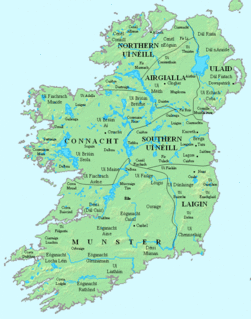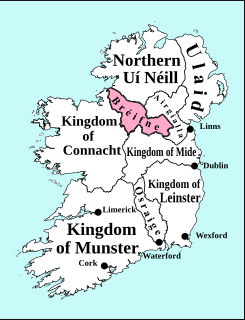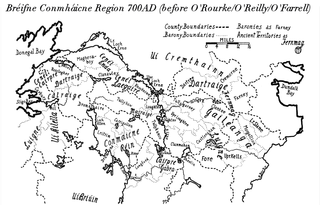Related Research Articles

Connacht, or Connaught, is one of the provinces of Ireland, in the west of Ireland. Until the ninth century it consisted of several independent major Gaelic kingdoms.
The Second Battle of Athenry took place at Athenry in Ireland on 10 August 1316 during the Bruce campaign in Ireland.

Uí Fhiachrach Aidhne was a kingdom located in what is now the south of County Galway.

West Connacht was a kingdom of Gaelic Ireland, associated geographically with present-day County Galway, particularly the area known more commonly today as Connemara. The kingdom represented the core homeland of the Connachta's Uí Briúin Seóla kindred and although they ruled, there were smaller groups of other Gaels in the area, such as the Delbhna Tir Dha Locha and the Conmhaícne Mara. It existed from 1051 onwards, after the Ó Conchobhair, Kings of Connacht, pushed the Ó Flaithbheartaigh to the West of Lough Corrib, from their original territory of Maigh Seóla. Iar Connacht remained a subordinate túath of Connacht, until the 13th century, after which it was more independent.

Maigh Seóla, also known as Hy Briuin Seola, was the territory that included land along the east shore of Lough Corrib in County Galway, Ireland. It was bounded to the east by the Uí Maine vassal kingdom of Soghain and extended roughly from what is now Clarinbridge in the south to Knockmaa Hill in the north. Its rulers belonged to the Uí Briúin Seóla and are sometimes found in the annals under the title "King of Uí Briúin" and "King of South Connacht". The earliest identifiable kings belonged to the line that became the Clann Cosgraigh. However in later times the line which would become the Muintir Murchada, under the O'Flaherty chiefs, monopolized the kingship.

The Delbna or Delbhna was a Gaelic Irish tribe in Ireland, claiming kinship with the Dál gCais, through descent from Dealbhna son of Cas. Originally one large population, they had a number of branches in Connacht, Meath, and Munster in Ireland.

Uí Mháine, often Anglicised as Hy Many, was one of the oldest and largest kingdoms located in Connacht, Ireland. Its territory of approximately 1,000 square miles (2,600 km2) encompassed all of what is now north, east and south County Galway, south and central County Roscommon, an area near County Clare, and at one stage had apparently subjugated land on the east bank of the Shannon, together with the parish of Lusmagh in Offaly.
Toirdhealbhach Mór Ua Conchobhair anglicised Turlough Mór O'Conor, was King of Connacht (1106–1156) and High King of Ireland.

The city of Galway Ireland was built as a naval base and military fort by Tairrdelbach mac Ruaidri Ua Conchobair in 1124, refounded as a military outpost and town by Richard Mor de Burgh in 1230 - has been subjected to a number of battles, sacks and sieges. This article enumerates the history of military conflict in Galway.
Ruaidri mac Tairdelbach Ua Conchobair, King of Connacht, died 1384. The previous king though not listed was slain and defeated by the Ó Cellaigh's of Ui Maine.
Cathal mac Murchadh was 29th King of Uí Maine, died 816.

The Kingdom of Breifne or Bréifne, anglicized as Breffny, was a medieval overkingdom in Gaelic Ireland. It comprised what is now County Leitrim, County Cavan and parts of neighbouring counties, and corresponds roughly to the Roman Catholic Diocese of Kilmore. It had emerged by the 10th century, as a confederation of túatha headed by an overking drawn from the Uí Briúin Bréifne.
Dartraighe, anglicised as Dartree, Dartry or Dartrey, was an Irish territory or tuath in medieval Ireland which stretched north to Clones and south to the Dromore River. It was later incorporated into County Monaghan as the barony of Dartree.

Muintir Murchada was the name of an Irish territory which derived its name from the ruling dynasty, who were in turn a branch of the Uí Briúin. The name was derived from Murchadh mac Maenach, King of Uí Briúin Seóla, who died 891.
Fearghal Ó Taidg an Teaghlaigh, Chief of the Name, Marshal and bodyguard of King Cathal Crobhdearg Ua Conchobair of Connacht and his successor, Aedh, died 1226.
Aedh Ailghin was the 22nd King of Uí Maine.

Gailenga was the name of two related peoples and kingdoms found in medieval Ireland in Brega and Connacht.
The Fortúatha were "kingdoms not ruled directly by members of the dominant dynasty of a province". They have also been described as "in effect, people belonging to a different stock from that of the rulers of the territory", yet sometimes enjoying a position of favour with the ruling people.
The Uí Fiachrach were a royal dynasty who originated in, and whose descendants later ruled, the coicead or fifth of Connacht at different times from the mid-first millennium onwards. They claimed descent from Fiachrae, an older half-brother of Niall Noigiallach or Niall of the Nine Hostages. Fiachrae and his two full brothers, Brion and Ailill, were the collective ancestors of the Connachta dynasty that eventually became the new name of the province. Their mother was Mongfind.

Between the 5th and 12th centuries, an Irish sept claiming descent from Coirpre mac Néill ruled a barony of north Tethbae, called Cairpre Gabra. Their territory corresponds to the barony of Granard in modern county Longford in Ireland.
References
- Irish Kings and High Kings, Francis John Byrne, (page 237), Dublin, 1973.